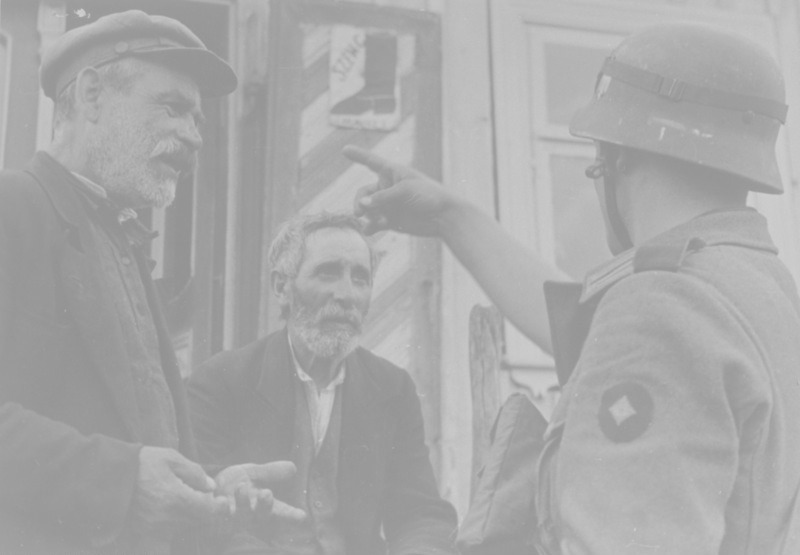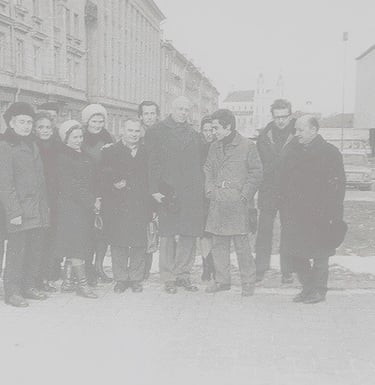It is highly courageous of you to join the hopeful, but very dangerous, path of the dissidents. I’m sorry, I’m getting ahead of myself. Here's how this will work.
When you start the tour, you will find audio that you can listen to and text you can read while at the relevant location. Once you finish the audio or text, you will find Google Maps directions to the following location. Simply click "View larger map" and/or "Directions" and it will show you how to get there. Once you reach the location, click "Continue" to find information on the following objective.
Now, let’s start the Dissident Tour of Vilnius from the beginning so you can understand what you are really getting yourself into. Scroll down to find the first audio clip!
Welcome!
Of course, you already know that after the First World War, during the interwar period, Lithuania was an independent state. We had our own presidents (three of them!) parliamentarians, and all of the other necessary gears of a functioning country. However, in August 1939, the Soviet Union and Nazi Germany signed the German–Soviet Nonaggression Pact as well as its Secret Additional Protocol, dividing Central and Eastern Europe into spheres of influence. Even though Lithuania was initially assigned to the German sphere, likely due to its economic dependence on German trade, the country still caused some dispute between the two opposing blocs.
When Germany invaded Poland in September 1939, the Wehrmacht took over the Soviet controlled Lublin and eastern Warsaw. To compensate the Soviet Union for this loss, a secret agreement transferred Lithuania to the Soviet sphere of influence. This secret agreement provided the justification for the Soviet Union to occupy Lithuania on June 15, 1940, thus establishing the Lithuanian SSR.
Within the first year of this occupation, Soviets caused tremendous losses for us, the Lithuanian nation. The “Sovietization” of existing political, religious and even cultural policies, destroyed the economy and caused the imprisonment of thousands of political activists. People like me. And you.
On June 22nd, 1941, just over a year after we were occupied by the Soviets, the Nazi army invaded the Lithuanian SSR. Their rapid advancement was due, in no small part, to the assistance of Lithuanians, who viewed the German military as a hope to re-establish our independence. As you know, this was not to be. We found ourselves occupied by Nazis for the next several years and, sadly, our prosperous Jewish community was destroyed.
In 1944, the Soviet Union reoccupied Lithuania as part of the Baltic Offensive, reinstating all of the repressive laws and policies, which were aimed at destroying Lithuanian culture and our sense of nationality as much as possible. The goal was to create an obedient, soviet-worshipping nation, exiling and deporting the rebellious part of the population to Siberia.
Nevertheless, as the years of Lithuanian occupation continued, we dissidents started finding ways to resist the sovietization policies. We worked hard to maintain our heritage; national, religious, cultural, historical... all of the things which make us Lithuanians. Sure, the nation was conflicted about the methods of resistance – should it be armed or peaceful – but either way, we never gave in to the influence of the soviets.
With people like you joining us, the dissident community in Lithuania grew stronger. The religious community prepared the “Chronicle of the Catholic Church of Lithuania,” which served as a journal to record the numerous political and human rights abuses. Various underground writers and publishers created anti-propaganda and pro-independence publications. Others networked with dissidents from other parts of the Soviet Union, as well as established connections in the Western world, trying to find a way to voice, loudly, the abuses going on here in the USSR. Protests and riots were common…but so were the subsequent detentions, interrogations, and searches by the KGB. So many of our fellow dissidents were kept in mental institutions as a result of the invented diseases of Soviet mental health “expert” Andrei Snezhnevsky. Fabricated disorders, like “paranoid reformist delusion” or “sluggish schizophrenia,” were used as tools to lock up dissidents indefinitely.
Indeed, my new friend, the life of a dissident during the Soviet Occupation is a scary one. But. Please, do not let that discourage you. With your help, I know we will be successful. Come now, let us see what this dissident world really looks like. Let's start with the first location - make sure you are here before you go to the next chapter.
First stop: Restaurant "Neringa"




